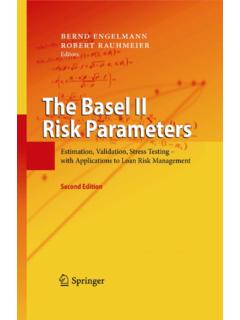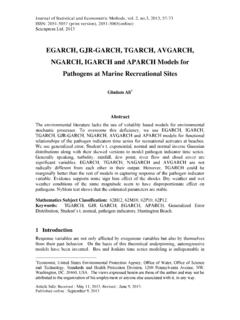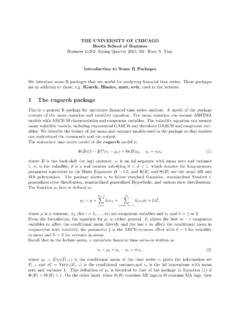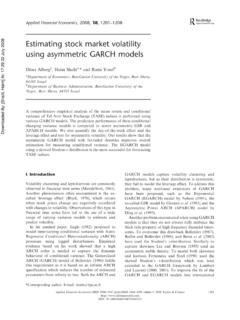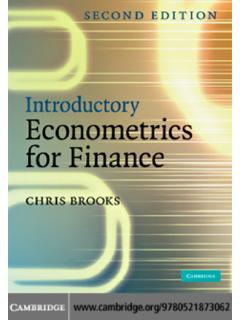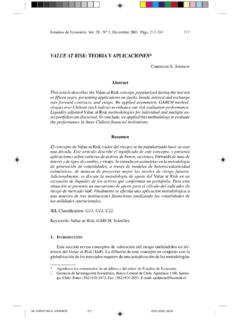Transcription of Computational Risk Management
1 Computational Risk Management Series Editors Desheng Dash Wu David L. Olson John R. Birge For further volumes: . Desheng Dash Wu Editor Quantitative Financial Risk Management Editor Desheng Dash Wu University of Toronto Risklab Spadina Crescent 1. M5S 3G3 Toronto Ontario Canada ISSN 2191-1436 e-ISSN 2191-1444. ISBN 978-3-642-19338-5 e-ISBN 978-3-642-19339-2. DOI Springer Heidelberg Dordrecht London New York Library of Congress Control Number: 2011930728. # Springer-Verlag Berlin Heidelberg 2011. This work is subject to copyright. All rights are reserved, whether the whole or part of the material is concerned, specifically the rights of translation, reprinting, reuse of illustrations, recitation, broadcasting, reproduction on microfilm or in any other way, and storage in data banks. Duplication of this publication or parts thereof is permitted only under the provisions of the German Copyright Law of September 9, 1965, in its current version, and permission for use must always be obtained from Springer.
2 Violations are liable to prosecution under the German Copyright Law. The use of general descriptive names, registered names, trademarks, etc. in this publication does not imply, even in the absence of a specific statement, that such names are exempt from the relevant protective laws and regulations and therefore free for general use. Cover design: SPi Publisher Services Printed on acid-free paper Springer is part of Springer Science+Business Media ( ). Preface The past financial disasters have led to a great deal of emphasis on various forms of risk Management such as market risk, credit risk and operational risk Management . Financial institutions such as banks and insurance companies are further motivated by the need to meet various regulatory tendency toward an integrated or holistic view of risks. In USA, the Global Association of Risk Professionals (GARP), and the Profes- sional Risk Managers' International Association (PRMIA) were established since 1996 and 2002 respectively.
3 In Canada, the Government of Canada, the Govern- ment of Ontario and financial sector leaders recently launched the Global Risk Institute in Financial Services (GRi) in Toronto, with the aim of T building on Canada's growing reputation in financial risk Management . Enterprise risk Management (ERM) is an integrated approach to achieving the enterprise's strategic, programmatic, and financial objectives with acceptable risk. ERM generalizes these concepts beyond financial risks to include all kinds of risks. Enterprise risk Management has been deemed as an effective risk Management philosophy. We have tried to discuss different aspects of risk, to include finance, information systems, disaster Management , and supply chain perspectives (Olson and Wu 2008a, b, 2010). The bulk of this volume is devoted to address four main aspects of risk manage- ment: market risk, credit risk, risk Management from both in macro-economy and enterprises.
4 It presents a number of modeling approaches and case studies that have been (or could be) applied to achieve risk Management in various enterprises. We include traditional market and credit risk Management models such as Black . Scholes Option Pricing Model, Vasicek Model, Factor models, CAPM models, GARCH models, KMV models and credit scoring models; We also include advanced mathematical techniques such as regime-Switching models to address systematic risk, H-P Filtration techniques to manage energy risks. New enterprise risks such as supply chain risk Management are also well studied by a few authors in this volume. We hope that this book provides some view of how models can be applied by more readers aiming to achieve quantitative financial risk Management . Toronto ON Canada Desheng Dash Wu November 2010. v vi Preface References Olson DL, Wu D (2008a) Enterprise risk Management . World Scientific, Singapore Olson DL, Wu D (2008b) New frontiers in risk Management .
5 Springer, Heidelberg Olson DL, Wu D (2010) Enterprise risk Management models. Springer, Heidelberg Contents Part I Market Risk Management Empirical Analysis of Risk Measurement of Chinese Mutual Funds .. 3. Ju Yang Assess the Impact of Asset Price Shocks on the Banking System .. 15. Yuan Fang-Ying Comparative Study on Minimizing the Risk of Options for Hedge Ratio Model of Futures .. 29. Luo Wenhui The Application of Option Pricing Theory in Participating Life Insurance Pricing Based On Vasicek Model .. 39. Danwei Qiu, Yue Hu, and Lifang Wang The Study of Applying Black-Scholes Option Pricing Model to the Term Life Insurance .. 47. Lifang Wang, Yue Hu, and Danwei Qiu Evolutionary Variation of Service Trade Barriers in Banking: A Case of ASEAN+3 .. 55. Xiaobing Feng Corporate Board Governance and Risk Taking .. 63. Shenglan Chen The Risk Factors Analysis of the Term Structure of Interest Rate in the Interbank Bond Market.
6 71. Yujun Yang, Hui Huang, and Jing Pang vii viii Contents Pricing of Convertible Bond Based on GARCH Model .. 77. Mengxian Wang and Yuan Li Sentiment Capital Asset Cognitive Price and Empirical Evidence from China's Stock Market .. 87. Wei Yan, Chunpeng Yang, and Jun Xie Carbon Emission Markets .. 95. Walid Mnif and Matt Davison Part II Credit Risk Management Dynamic Asset Allocation with Credit Risk .. 111. Bian Shibo and Zhang Xiaoyang Analysis of the Factors Influencing Credit Risk of Commercial Banks .. 123. Tao Aiyuan and Zhao Sihong The Credit Risk Measurement of China's Listed Companies Based on the KMV Model .. 137. Zhang Piqiang and Zhou Hancheng Consumer Credit Risk Research Based on Our Macroeconomic Environment .. 161. Zhu Ning and Shi Qiongyao Wealth Effects of the Creditor in Mergers: Evidence from Chinese Listed Companies .. 173. Zhihui Gu and Xiangchao Hao Part III Risk Management in Enterprises Research on the Economy Fluctuations with Energy Consumption of China Based on H-PFiltration.
7 191. Hua Wei, Haiyan Tang, Shan Wu, and Yaqun He Enterprise Risk Assessment and Forecast: Based on Chinese Listed Companies in 2009 2010 .. 201. Shao Jun, Wang Shuangcheng, and Liu Yanping The Prevention and Control of Environmental Liability Based on Environmental Risk Management and Assessment in Enterprise .. 217. Zhifang Zhou and Xu Xiao Contents ix Supply Chain Risk Management Review and a New Framework for Petroleum Supply Chains .. 227. Lea o Jose Fernandes, Ana Paula Barbosa-Po voa, and Susana Relvas Towards a Supply Risk Management Capability Process Model: An Analysis of What Constitutes Excellence in Supply Risk Management Across Different Industry Sectors .. 265. Kai Fo rstl, Constantin Blome, Michael Henke, and Tobias Scho nherr Enterprise Risk Management from Theory to Practice: The Role of Dynamic Capabilities Approach the Spring Model .. 281. Amerigo Silvestri, Marika Arena, Enrico Cagno, Paolo Trucco, and Giovanni Azzone Part IV Risk Management in Macro-economy Risk Index of China's Macroeconomic Operation: Method and Application.
8 311. Wang Shuzhen and Jia Dekui Systemic Risk .. 321. Johannes Hauptmann and Rudi Zagst . Part I. Market Risk Management . Empirical Analysis of Risk Measurement of Chinese Mutual Funds Ju Yang Abstract Investment funds in China started in 1991. After 20 years of develop- ment, the mutual fund industry is now offering a rich product line for investors. At present, individual investors hold about 90% of the mutual fund with more than 90,000,000 fund accounts. Mutual fund purchasing has become the preferred way of managing money for urban residents in China. This paper study on risk assess- ment methods of investment fund. An empirical analysis of the selected 15 mutual funds in China is performed with testing models of VaR, Semi-Parameter VaR and GARCH-VaR. After testing of these models, these selected funds demonstrated some of characteristics of China funds. As to risk assessment methods, we find that Semi-Parameter VaR is relatively simple in calculation but the resulting confidence interval is too wide for practical application.
9 Comparatively GARCH-VaR is found to be more rational and precise. GARCH-VaR method has better precision than conventional performance index. Keywords Mutual funds Risk Management Semi-Parameter VaR model . GARCH-VaR. 1 Introduction Investment funds in China started in 1991, with the mark as promulgation and implementation of in Interim Measures for the Administration of Securities Investment Funds in October 1997. In March 1998 Guotai and Kaiyuan Securities Investment Fund was set up, marking the beginning of securities investment fund and its dominant direction in the industry in China. In 2001, Hua An Innovative Investment Fund started the first open-end fund, marking another stage in China's fund industry development. J. Yang School of Finance, Shanghai Institute of Foreign Trade, Shanghai, People's Republic of China e-mail: Wu (ed.), Quantitative Financial Risk Management , Computational Risk Management , 3. DOI , # Springer-Verlag Berlin Heidelberg 2011.
10 4 J. Yang On 29 April 2005, the China Securities Regulatory Commission (CSRC) issued a The share holder structure reform of the listed companies . It proposed a reform of non-tradable shares which was unique in China's stock market then. Conse- quently Chinese stock market ended nearly 5 years long of downward trend since June 2001. The Shanghai (securities) composite index rose from 1,160 points (6 January 2006) to 5,261 (28 December 2007). It reached the highest point of 6,124 on 19 October 2007 in the history of the China Securities Index. By the end of 2007, the total number of funds in China has reached 341 with a total net asset value of trillion yuan. Besides the 39 closed-end mutual funds, there are 145 Stock funds, 82 Asset Allocation funds, 40 Money Market Funds, 17. General Bond funds, 5 Short-term Debts, 7 Guaranteed funds, and 6 Conservative Allocation funds. After 20 years of development, the mutual fund industry is now offering a rich product line for investors.
